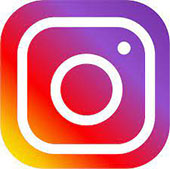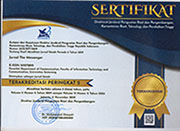Representation of Orientalism in Sunsilk Print Advertising
Abstract
Using the qualitative method, the critical paradigm, and also Roland Barthes semiotic analysis, this study aims to find out the symbols contained in Sunsilk Co-creations print advertising, the meaning contained in the symbols and how the symbols subordinate the Eastern people. The results of this study indicate that there are seven symbols in Sunsilk Co-creations version print advertising that has unity meaning, i.e there are dominant people who are showed as more superior thus there are other people who are considered inferior. With the myth that the West is better seen as the superior and the East is seen as the inferior, then the symbols and meanings in Sunsilk Co-creations print advertising represent orientalism. The researchers suggest to pay attention to the symbols that will be aired so as not to be negative because it can affect the reputation of the company/institution concerned. Besides that, it is expected to the Eastern people especially Indonesian to be able to change their thought to be more proud and show their confidence.
Keywords
Full Text:
PDFReferences
Dian, L. (2016). I Know Your Gesture. Yogyakarta: Pustaka Baru Press.
Foss, K. A. & Littlejohn, S. W. (2008). Theories of Human Communication. Belmont: Thomson Wadsworth.
Hendratman, H. (2006). Computer Graphics Design. Bandung: Informatika.
N ¶th, W. (1995). Handbook of Semiotics. Bloomington: Indiana University Press.
Olson, S. (2002). Mapping Humas History: Discovering the Past through Our Genes. New York: Mariner Book.
Paludi, M. A. (2013). Psychology for Business Success. England: Praeger.
Piliang, Y. A. (2003). Hipersemiotika: Tafsir Cultural Studies atas Matinya Makna. Bandung: Jalasutra.
Ramdani, Z. P. (2015). Gesture: Mengungkap Makna di Balik Bahasa Tubuh Orang Lain dan Mikroekspresi hingga Makroekspresi. Klaten: PT HAFAMIRA.
Reiman, T. (2007). The Power of Body Language: How to Succeed in Every Bussiness and Social Encounter. New York: Pocket Books.
Sumarwan, U. (2003). Perilaku Konsumen Teori dan Penerapannya dalam Pemasaran. Jakarta: Ghalia Indonesia.
Azis, A. A., Cangara, H., & Bahfiarti, T. (2015). Konstruksi Pencitraan Maskulinitas pada Majalah Men S Health Indonesia versus Feminitas Pada Majalah Women S Health Indonesia. Jurnal Kareba, 4(4): 399 414.
Fanani, F. (2011). Mitologi dalam Video Game: Pesan-Pesan Politik dalam Video Games Amerika Serikat. Jurnal The Messenger 3(1).
Hafiar, H., Mahameruaji, J. N., & Rahmawan, D. (2017). Analisis Semiotika pada Cover Novel Trilogi karya Vira Safitri. Jurnal Nomosleca 3(April).
Nuswantara, J. P. (2014). Pesan Sosial dalam Foto Jurnalistik (Analisis Semiotika dalam Buku 'Jakarta Estetika Banal', Bab I, III, V dan VII). Jurnal The Messenger 6(1): 14-21.
Pebrianti, F. (2013). Penggunaan Diksi pada Iklan Produk Unilever di Stasiun Televisi SCTV. Jurnal Bahasa dan Sastra, 2(2): 1 15.
Sabath, A. M. (2004). Beyond Business Casual: What to Wear to Work if You Want to Get Ahead. Limcoln: ASJA Press.
Stephanie, R. F. (2014). Representasi Mooi Indie (Hindia Molek) dalam Iklan Pariwisata Indonesia. Jurnal Ilmu Komunikasi. http://e-journal.uajy.ac.id/6577/
Taha, M. H. (2014). Gratifying the 'Self' by Demonizing the 'Other': A Call for Dialogue not Monologues. J. Sage: 1-13. http://journals.sagepub.com
Tinarbuko, S. (2009). Semiotika Komunikasi Visual. Yogyakarta: Jalasutra.
Wardyaningrum, D. (2012). Penggunaan Daya Tarik Emosional pada Iklan Pajak di Televisi. Jurnal Al-Azhar Indonesia Seri Pranata Sosial, 1(4): 249-258.
Basuki, A. (2015). Makna Warna dalam Desain. Retrieved April 30, 2017, from
http://basuki.lecturer.pens.ac.id/lecture/MaknaWarnaDalamDesain.pdf
Darry, M. (2013). Orientalisme. Retrieved May 21, 2016, from http://mohammad-darry-fisip12.web.unair.ac.id/artikel_detail-79327-Ide%20%20Ide%20Politik% 20Alternatif-Orientalisme.html
Hazan, R. (2016). About Us. Retrieved December 25, 2016, from https://ritahazan.com/pages/about-us#rita
https://www.hamadibeauty.com/pages/meet-jamal
http://mohammad-darry-fisip12.web.unair.ac.id/
http://www.rudyhadisuwarno.co.id/about-us
http://www.wexlerdermatology.com/meet-our-experts/francesca-fusco#sthash. hIY1qLqQ.dpbs
Ipeh dkk. (2011). Pengaruh Tingkat Pendidikan Masyarakat terhadap Jenis Pekerjaan di Kecamatan Ngemplak Kabupaten Boyolali. Retrieved May 30, 2017, from http://ipahipeh.blog.fisip.uns.ac.id
Markaz Production. (2015). Syarat Untuk Menjadi Model. Retrieved May 24, 2017, from http://markaz-production.com/syarat-untuk-menjadi-model/
Nasution, J. (2017). Membaca Pikiran Seseorang Lewat Bahasa Tubuh. Retrieved May 30, 2017, from http://www.academia.edu/25860877/Membaca_Pikiran_Seseorang_Lewat_Bahasa_Tubuh
Ouidad. (2016). Our Heritage. Retrieved December 25, 2016, from https://www.ouidad.com/our-heritage
Sunsilk. (2016). Retrieved December 23, 2016, from http://www.sunsilk.in/
Sunsilk. (2016). Teddy. Retrieved December 25, 2016, from https://www.sunsilk.in/experts/teddy.html
Sunsilk. (2016). Thomas Taw. Retrieved December 25, 2016, from http://www.sunsilk.co.id/artikel/detail/1153632/thomas-taw
Sunsilk. (2016). Yuko Yamashita. Retrieved December 25, 2016, from http://www.sunsilk.co.id/artikel/detail/1153625/yuko-yamashita
Sunsilk. (2016). 7 Sunsilk Experts. Retrieved March 25, 2016, from http://www.sunsilk.com.pk/7-sunsilk-experts/
Wahyuningtias, D. (2017). Peran Gesture (Gerak Tubuh) Guru sebagai Upaya Menumbuhkan Perhatian Siswa pada Pembelajaran Pendidikan Agama Islam di Sekolah Menengah Kejuruan Ketintang Surabaya. Skripsi. Retrieved April 28, 2017, from http://digilib.uinsby.ac.id/2198/5/Bab%202.pdf
Wibawa, S. W. (2016). Apa Arti Kode Busana 'Business Casual'? Retrieved April 2, 2017, from http://lifestyle.kompas.com/read/2016/07/05/190400620/apa.arti.kode.busana.business.casual
Wicaksono, B. D. (2016). Ini 8 Alasan Kenapa Banyak Orang Indonesia Mudah Percaya Hoax atau Kabar Bohong. Retrieved May 20, 2017, from https://hype.idntimes.com/viral/bayu/ini-8-alasan-kenapa-banyak-orang-indonesia-mudah-percaya-hoax-atau-kabar-bohong/full
DOI: http://dx.doi.org/10.26623/themessenger.v10i2.744
Refbacks
- There are currently no refbacks.
Copyright (c) 2018 Jurnal The Messenger
View My Stats [Jurnal The Messenger] is an International Scientific Journal, Published by the Department of Communication, Faculty of Information Technology and Communication, Universitas Semarang (Central Java, Indonesia). It is licensed under a Creative Commons Attribution 4.0 International License.



_11.jpg)




_BARCODE.jpg)
_BARCODE1.jpg)


5.png)










2.png)





